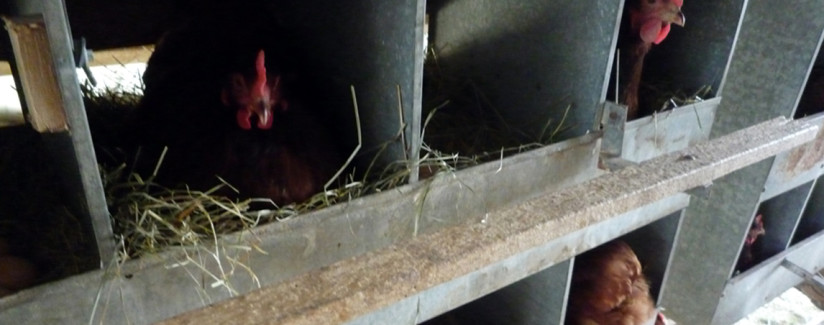
Eggs – Organic, Cage-Free, Free-Range; What’s The Difference? Part Two
07/28/2011
Just what do chickens do all day – and why are some kept in cages? What does it take for hens to lay the eggs my family eats for breakfast? In the second installment of our three-part series, Best Food Facts talked with two experts, Dr. Darrin Karcher, poultry extension specialist at Michigan State University, and Dr. R. Scott Beyer, associate professor at Kansas State University, to answer those questions and more.
Chickens that provide us with eggs are called “egg laying hens.” What is their average day like? Do they have a schedule? What behaviors do they exhibit?
Dr. Karcher:
If we looked at a typical egg laying hen, I would say they probably do have a daily schedule. Typically when the lights come up they are going to wake up and start to socialize with each other. They will find a location in which to lay their egg, drink and eat. Occasionally they might dust-bathe, or wing flap.
What do hens need in order to produce safe, nutritious eggs?
Dr. Beyer:
There are several things hens need to have in order to produce high quality eggs. An environment with a temperature of 54 – 78 degrees Fahrenheit is ideal. In terms of proper nutrition, hens can’t be over-fed and they can’t be underfed, or it will deplete their bone structure, potentially cause pecking and cannibalism, and could even cause fewer eggs to be produced. It’s also very important for those who are taking care of the hens to observe the status of the entire flock of birds. When doing so, we are checking to ensure their behaviors are normal, they’re active and that they’re not exhibiting signs of stress.
Dr. Karcher:
The most important things hens need to produce eggs is a constant source of quality feed, clean water and proper lighting conditions. By providing these elements, it allows the hen to produce her eggs more efficiently.
Why do a lot of producers keep egg laying hens inside barns and in cages?
Dr. Beyer:
Something unique about poultry is that they can interact with other birds in the environment, if they’re allowed to be outdoors. That presents a problem when you have outside birds introducing parasites and diseases into the flock by flying overhead or mingling together with the flock. An example would be wild geese flying over an outdoor flock and dropping fecal matter into pens. That’s the premise behind raising hens in barns.
The reason for cages is completely different. Cages have automatic feeding and watering systems that allow farmers to collect the eggs easily. This not only means farmers don’t have to search for eggs, it also means the eggs aren’t sitting in fecal matter (which is important for food safety), that they’re not stepped on, and ultimately, it reduces the cost consumers pay for eggs, because it is a more efficient system on the farm. Cages also segregate the hens, which is important, because they can be very mean to one another; cannibalization is not uncommon among hens. Finally, if you have a sick bird, it keeps that bird from spreading the illness across the entire barn.
Dr. Karcher:
Our eggs used to be produced with smaller flocks that were outside. However, we found that if we could move hens to cages inside a building we could better monitor and regulate their environment to keep them safe and comfortable. As an example, instead of exposing hens to extreme weather, heat and cold, we can make a tempered environment for the hens. We are also able to provide the hens with sufficient lighting and continuous water and feed.
Another thing we have found is that if we move hens into cages, we eliminate interaction with their feces. This means we can produce eggs that are cleaner, reduce the risk of disease and eliminate the hens from interacting with wild birds and predators outdoors.
All of these factors mean that we can care for the hens in a more wholesome way than we could if they were exposed to the different outdoor elements.
Will the taste or nutritional quality of eggs differ based on how the hen is raised?
Dr. Beyer:
This is something that hasn’t been studied very much, but that many people have opinions on. My answer is no. Even an ostrich egg, compared to a chicken egg, has about the same nutrient components. The reason it doesn’t change is that these eggs are going to grow an embryo, and that embryo needs certain components to form, or it’s not successfully going to hatch a chick. So changing the housing systems is probably not going to lead to big changes that we can detect in taste or nutrition.
This is the second post of a three-part series. Be sure to check out Part One and Part Three.
Image: “P1080832” by Jessica “The Hun” Reeder is licensed under CC BY 2.0.



























